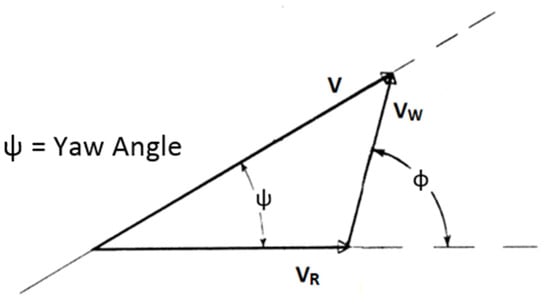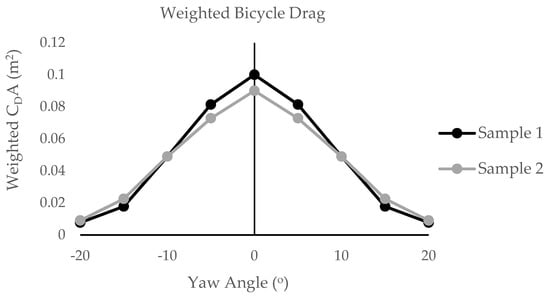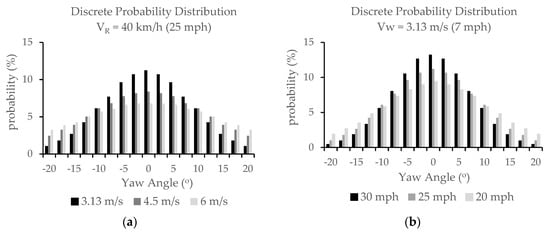Abstract
Aerodynamic drag is a key determinant of cycling performance. The distribution of yaw angles that a cyclist experiences is equally important. Analysis and presentation of aerodynamic data in cycling, generally, has not combined these two effects. A theoretical derivation of a probability density function for yaw angle weighting, based on the theory of Wind Averaged Drag is presented. The weighting function allows for functional variation of yaw distribution according to road and wind speed as well as the visual representation of yaw distribution applied to graphical wind tunnel data. A normalised average of the weighted curve combines both drag and yaw angle data into a single value which is essential for performance modelling. This approach provides a more intuitive way to view and interpret yaw angle data and aerodynamic performance. This has the potential to standardise performance analysis in the industry and improve athletes’ understanding of complex aerodynamic phenomena.
1. Introduction
Aerodynamics has been well established as being critical to cycling performance. The validated power model for cycling described by Martin et al. [1] has shown that aerodynamics is the dominant form of resistance on a cyclist at speeds above 15 km/h, using typical values. At racing speeds of 45 km/h aerodynamics can comprise 80–90% of the total power required of an athlete [1,2]. For ground vehicles, aerodynamic performance is also dependent on the environmental wind conditions, which combine with road speed to create an angle of incidence between the bicycle’s direction of travel and the resultant wind vector; termed the yaw angle (Figure 1). As vehicle drag varies with yaw angle, an understanding of potential operating wind conditions is important for predicting and modelling performance.

Figure 1.
Yaw Angle (ψ) as a function of road speed (VR), wind speed (VW) and wind direction (φ).
Numerous efforts have been made to characterise the variation in yaw angle experienced by a vehicle on the road. Cooper [3] showed that the probability of exceeding a given yaw angle is maximum at zero and exponentially decaying as yaw increases. This data showed that for a road speed of 30 mph, representative racing speed for cycling, 90% of time is spent at a yaw angle less than 16°. As road speed increases, probability of seeing high yaw angles decreases as the maximum possible yaw angle, for a given wind speed, is reduced. This exponential decay of yaw probability centered on 0° has also been reported by groups in the cycling industry, primarily through on-road measurement [4,5,6,7,8].
Aerodynamic data from wind tunnel tests are typically reported graphically showing the variation of drag with yaw angle. Given an understanding of yaw angle distribution it becomes apparent that drag at all yaw angles is not equally significant. This becomes important when trying to model performance as it is most useful to have a single value of drag that incorporates weighting according to yaw angle.
This concept was identified by the automotive industry four decades ago and resulted in the derivation of Wind Averaged Drag (WAD), which is now recommended practice by the Society of Automotive Engineers (SAE). WAD involves the weighted averaging of drag at different prescribed yaw angles to provide a single unit. The SAE method uses a simplified yaw weighting function as defined by Drollinger [9] by assuming constant wind speed. Wind Averaged Drag has been presented in the cycling industry previously [10] but has not been widely adopted, perhaps due to the lack of visual representation of the yaw weighting effect and the results are therefore not intuitive or accessible to many end users of aerodynamic data. There is also no cycling industry body to govern experimental practice such as the SAE.
To enhance the analysis and interpretation of aerodynamic data, the cycling industry requires an intuitive and visual methodology for objectively evaluating the importance of drag at a different yaw angles. Generating a weighted yaw angle curve in this way allows for that data to be condensed into a single value of drag that will simplify comparison and interpretation and for use in performance modelling.
2. Materials and Methods
To objectively evaluate the significance of different yaw angles to a cyclist a general solution for the statistical distribution of those yaw angles is required. This is difficult to generate from on-road measurements due to the key variables of rider speed, wind speed and wind direction varying with both geographical location as well as time. Therefore, measurement can require a monumental experimental campaign. A theoretical approach to this problem would be more efficient, plus has the potential to accommodate functional variation of wind speed and rider speed. Drollinger [9] presents a derivation of the yaw weighting function (W) as a function of yaw angle (ψ). This is a function of probability distributions for wind direction (pφ) and wind speed (pVw) for a given vehicle speed. This method is the origin of the SAE Wind Averaged Drag but will be applied differently for cycling in this paper.
The denominator in Equation (1) is a normalising term to ensure that the resulting probability density function has an area of unity. Solving this double integral results in a probability density function of yaw angle. Normalising this PDF into a weighting curve can then be used to transform drag vs. yaw angle data collected from wind tunnel tests and used to evaluate and compare aerodynamics performance. The three key inputs in this equation are the probability density functions for wind direction (pφ) and wind speed (pVw) as well as a magnitude weighting term for speed (V*). These will be addressed individually.
2.1. Wind Direction
Deriving a probability distribution for wind direction is problematic due to the massive variation that occurs globally, as it depends not only on the direction of the wind but relative direction of travel of the cyclist. To find a general solution it is, therefore, most reasonable to assume that the probability of the oncoming wind angle is equal from all possible directions. Effectively then we define pφ as a constant value where;
This function applies to a numerical solution where the wind direction is divided into ‘n’ discrete angles. For a specific cyclist in a specific location this function will not be precise. However, the objective of this work is to identify a general solution for analysing aerodynamic performance, not to model a specific rider’s experience. The model could, however, be applied in such a way by replacing Equation (2) with a unique probability function of wind direction.
2.2. Wind Speed
The variation in wind speed is of significant importance to wind turbine siting as well as structural design and has received significant investigation from other industries. The Weibull distribution is commonly used to model wind speed and is a function of a shape and a scale factor [11]. The Rayleigh distribution (Equation (3)) is a special case of the Weibull distribution with a fixed shape factor.
where with mean = μ.
As a single parameter function, the Rayleigh distribution is typically not flexible enough for fitting to distribution data from specific locations, however, it provides a good generalisation for non-extreme wind cases. As a model for a general solution the approximation of a Rayleigh distribution is a reasonable approach. The Rayleigh distribution has the added benefit that the scaling parameter is a function of the mean. This is functionally useful as it means the wind speed and resulting yaw weighting function can be evaluated for various mean wind speeds to show the effect of wind speed on yaw angle probability. For applications to cycling a mean wind speed of 3.13 m/s (7 mph) is recommended to align with the SAE recommended practice J1252 [12]. This magnitude is consistent with typical mean wind speed measured at vehicle height (NOAA, ECMWF) and given the similarity of environmental conditions faced by bicycles and automobiles it is logical to align with the SAE practice.
2.3. Velocity Magnitude Weighting
The velocity magnitude weighting term (V*) is to account for the change in relative velocity with wind angle. Figure 1, shows that the relative velocity of a bicycle is a function of the wind vector and the road vector. When the ground and wind vectors are aligned the relative velocity magnitude is greater than when wind is perpendicular. This higher velocity equates to higher drag force, thus making these angles more significant. Therefore, V* is a purely geometric function of wind direction and velocity;
2.4. Application
The weighting probability function is generated by integrating Equation (1) numerically. Scripting this process results in a functional solution. This enables the generation of different weighting functions dependent on both mean wind speed and cyclist road speed. The solution to the integral is a discretised continuous probability density function which will be utilised in two ways. Firstly, the function can be integrated over bands to show the probability of a cyclist experiencing a given yaw angle. This is useful to show the effects of road speed and mean wind speed on yaw angle probability. Secondly, this PDF is used as a weighting function and applied directly to wind tunnel data. The weighting function is normalised by its maximum value and evaluated at each sample yaw angle from experiment. The product of the measured drag and the normalised weighting function can then be plotted as yaw weighted drag. The result is a visual representation of the relative significance of the drag at each yaw angle. This is depicted in Figure 2 and Figure 3 below using example drag curves of two theoretical bicycles. Similar to aerofoils, many bicycles exhibit ‘stall’ in the range of 10–15° where there is an inflection in the drag curve. This can result in large differences between two bicycles at high yaw with potentially intersecting curves, depending on the stall points (see Figure 2). This highlights the benefits of visually scaling graphical results as it reduces the magnitude of differences at high yaw, emphasizing the differences at low yaw (Figure 3) in proportion to the probability of a cyclist experiencing those conditions.

Figure 2.
(a) Example of two different drag curves for arbitrary bicycles; (b) The normalised weighting function for yaw angle. The product of these two curves generates a weighted drag curve (see Figure 3).

Figure 3.
Weighted drag curve; the product of the normalised weighting function and raw output from wind tunnel drag measurement. Note the change in vertical axis scale.
Condensing aerodynamic performance across a yaw sweep into a single unit is useful to remove subjective evaluation of the graphical data and is particularly useful when implementing values into a performance model. The most apparent approach is to take the integral of the weighted drag curve. However, this approach distorts the magnitude of the average, which, whilst useful for relative ranking, is not representative of real world drag. This is then unsuitable for use in modelling on road performance. The solution is to perform a weighted average of the yaw weighted drag curve. The result is termed the Yaw Weighted Drag, denoted CDA*, to distinguish it uniquely from the SAE Wind Averaged Drag (WAD).
Using the data in Figure 2 and Figure 3 above, CDA* for Sample 1 and Sample 2 can be calculated as 0.092 and 0.089 respectively. This highlights the importance of yaw weighting as Sample 1 has significantly lower drag at high yaw but this is offset by poor performance at the dominant low yaw angles. This approach scales with the number of sample points (j), ensuring that the magnitude of CDA* is not distorted, regardless of yaw resolution of experimental data. The key difference to the SAE WAD approach is that this method applies the weighting value to drag values at the measured yaw angle from wind tunnel results, making it directly applicable to experimental data. The SAE approach requires interpolation of drag to a set of prescribed yaw angles.
3. Results
The yaw angle probability distribution, and subsequently the weighting function, are functions of both road speed and mean wind speed. This allows for the modelling of different cases for faster or slower riders and for differing magnitudes of ambient wind. Figure 4a shows the discrete probability distributions for several cases of road speed and Figure 4b for different wind speeds.

Figure 4.
(a) Probability of yaw angle with varying road speed (VR); (b) Probability of yaw angle with varying mean wind speed (VW).
The results match intuition; increasing mean wind speed or decreasing road speed act to dilate the yaw probability distribution, giving more weight to the higher yaw angles. High road speed, and low mean wind speed have the opposite effect, increasing the dominance of low yaw angles. The output of these functions is generally consistent with data collected from on-road measurement [4,5,6,7,8]. However, on-road testing does not have the variable control and so inherently includes averaging over a range of road and wind speeds.
These probability distributions do not represent the wind conditions experienced by any particular athlete, but constitute a set of general solutions to assist in the understanding of aerodynamic data for real world cycling applications. It is, however, useful to have a single weighting curve for cycling that can be universally applied to all wind tunnel tests as a form of industry standard. This would provide an objective normalising procedure that fairly accounts for the effects of yaw angle, which would simplify the comparison and interpretation of aerodynamic performance, especially for groups of individuals that do not have a strong background in vehicle aerodynamics, such as athletes and coaches. Current cycling industry practice has centred on 30 mph as a test velocity. This has been driven by North American based manufacturers and is a reasonable speed for elite racing. For a universal weighting function it is proposed to use a road velocity (VR) of 25 mph (40.23 km/h, 11.18 m/s) as this is provides a balance as an attainable speed for amateur cyclists and is close to the average speed of elite stage races. For consistency, VW = 7 mph (3.13 m/s) is proposed so as to align cycling with the automotive industry. This value was reviewed as a part of SAE J1252 [12] and was measured to be 7.45 mph for North America. J1252 retains the 7 mph for historical consistency and is therefore a logical choice for cycling applications. Table 1 provides values of the normalised weighting function using VR = 25 mph and VW = 7 mph at a common wind tunnel yaw sampling schedule; symmetric about 0°.

Table 1.
Single sided yaw weighting function for VR = 25 mph (40.23 km/h, 11.18 m/s), VW = 7 mph (3.13 m/s). Function is symmetric about 0°.
4. Conclusions
A new method for interpreting the effect of yaw angle is presented for specific application to the cycling industry. The underlying probability distribution for yaw angle is derived theoretically using probability distributions for wind speed and direction. This method improves upon the SAE Wind Averaged Drag method by providing a visual method for interpreting the effect of yaw angle on experimentally measured drag that can be directly applied to sample data. A new concept, the Yaw Weighted Drag (CDA*), is presented as a method for condensing drag and yaw angle data into a single numeric that can be used to simplify the understanding of drag performance across all yaw angles. A yaw weighting curve with a wind speed of 3.13 m/s (7 mph) and road speed of 11.18 m/s (25 mph) is proposed as a candidate for industry standard practice for all cycling applications. The combined outputs of this method will assist in simplifying the analysis and interpretation of complex drag and yaw distributions for a wider audience including athletes and coaches.
Conflicts of Interest
The authors declare no conflict of interest.
References
- Martin, J.C.; Douglas, M.L.; Cobb, J.E.; McFadden, K.L.; Coggan, A.R. Validation of a mathematical model for road cycling power. J. Appl. Biomech. 1998, 14, 276–291. [Google Scholar] [CrossRef] [PubMed]
- Kyle, C.R.; Burke, E. Improving the Racing Bicycle. Mech. Eng. 1984, 106, 34–45. [Google Scholar]
- Cooper, K.R. Truck Aerodynamics Reborn—Lessons from the Past; SAE Technical Paper Series 2003-01-3376; Society of Automotive Engineers: Warrendale, PA, USA, 2003. [Google Scholar]
- McCormick, Z.; McCormick, N.; Clark, J. Mathematical Model of Yaw Angle Distributions for Bicycle Wheels; Catalyst Cycling LLC: Chattanooga, TN, USA, 2015. [Google Scholar]
- Flo Cycling. Available online: www.flocycling.com/aero.php (accessed on 1 June 2016).
- Mavic. Available online: http://engineerstalk.mavic.com/en/ (accessed on 1 June 2016).
- Swiss Side. Available online: https://www.swissside.com/blogs/news/the-swiss-side-instrumented-bike (accessed on 1 June 2016).
- Trek Bicycle Corp., The All-New Speed Concept. Available online: www.trekbikes.com (accessed on 1 April 2015).
- Drollinger, R.A. Heavy Duty Truck Aerodynamic; 33rd L. Ray Buckendale Lecture; Society of Automotive Engineers: Warrendale, PA, USA, 1987. [Google Scholar]
- Brownlie, L.; Ostafichuk, P.; Tews, E.; Muller, H.; Briggs, E.; Franks, K. The wind-averaged aerodynamic drag of competitive time trial cycling helmets. Procedia Eng. 2010, 2, 2419–2424. [Google Scholar] [CrossRef][Green Version]
- Morgan, E.C.; Lackner, M.; Vogel, R.M.; Baise, L.G. Probability distributions for offshore wind speeds. Energy Conserv. Manag. 2010, 52, 15–26. [Google Scholar] [CrossRef]
- SAE Surface Vehicle Recommended Practice; J1252; SAE Wind Tunnel Test Procedure for Trucks and Buses; Society of Automotive Engineers: Warrendale, PA, USA, 2012.
Publisher’s Note: MDPI stays neutral with regard to jurisdictional claims in published maps and institutional affiliations. |
© 2018 by the author. Licensee MDPI, Basel, Switzerland. This article is an open access article distributed under the terms and conditions of the Creative Commons Attribution (CC BY) license (https://creativecommons.org/licenses/by/4.0/).